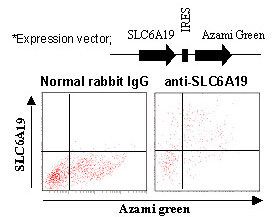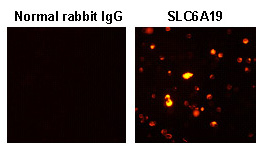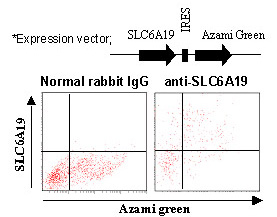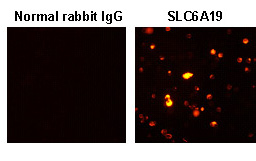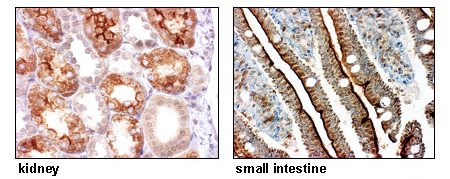Anti-SLC6A19 (B0AT1) (Human) pAb
| Code | Size | Price |
|---|
| MBL-BMP053 | 50 uL | £323.00 |
Quantity:
Prices exclude any Taxes / VAT
Overview
Host Type: Rabbit
Antibody Isotype: IgG
Antibody Clonality: Polyclonal
Regulatory Status: RUO
Target Species: Human
Applications:
- Flow Cytometry
- Immunocytochemistry (ICC)
- Immunohistochemistry (IHC)
Shipping:
4°C
Storage:
-20°C
Images
Documents
Further Information
Alternative Names:
B0AT1
Applications:
FCM - 1:1000 ICC - 1:1000 IHC - 1:1000 (Heat treatment required for paraffin)
Background:
SLC6A19, also known as B0AT1, is a member of the Na+ -dependent neurotransmitter transporter family, and mediates epithelial resorption of neutral amino acids across the apical membrane in the intestine and the proximal tubes of the renal cortex. Defective amino acid transport due to the mutation of the SLC6A19 gene causes Hartnup disorder, which is characterized by a pellagra-like light-sensitive rash, cerebellar ataxia, emotional instability, and aminoaciduria.
Formulation:
50 ul volume of PBS containing50% glycerol, pH 7.2. No preservative is contained.
Gene IDs:
Human: 340024 Mouse: 74338
Immunogen Translated:
Synthetic peptide derived from human SLC6A19
Reactivity:
This antibody can be used to stain endogenous antigen in paraffin embedded human tissues including kidney and small intestine by Immunohistochemistry. The reactivity has been confirmed by Western blotting, Immunocytochemistry and Flow cytometry to detect the full length of human SLC6A19 transiently expressed in HEK 293T cells.
Shelf Life:
1 year
Source:
This antibody was affinity purified from rabbit serum. The rabbit was immunized with a synthetic peptide derived from human SLC6A19.
Target:
SLC6A19
References
1)
Br?er, S., IUBMB Life 61, 591-599 (2009)
2)
Bohmer, C., et al., Biochem. J. 389, 745-751 (2005)
3)
Seow, H. F., et al., Nat Genet 36, 1003-1007 (2004)
4)
Kleta, R., et al., Nat Genet 36, 999-1002 (2004)
5)
Br?er, A., et al., J. Biol. Chem. 279, 24467-24476 (2004)


